Mighty A
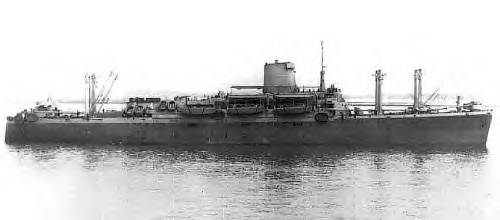
SS Ancon Goes to War
The Ancon was launched on 1938 at a cost of $ 5,000,000.00. She was a brand new addition of the Panama Line of ships. The other proud ships were SS Panama and the SS Cristobal. The Ancon as her sister ships was designed to carry both cargo and passengers from New York to Cristobal, Canal Zone.
The Ancon was a smart ship at 492 feet long, and a beam of 64 feet. She displaced 14,200 tons and could do 22 knots. Mrs. Harry Woodring, wife of then Secretary of War christened her September 24, 1938
On her maiden voyage on June 22, 1939, she was carrying 202 first class passengers, a crew of 125 and 6,000 tons of cargo from New York to Panama. In her peacetime garb she was magnificent. There were mirrored lounges, cocktail bars and dinning salon found on many liners of that time. Her passengers enjoyed a cool glass of Rum & coke, while they caught up on the news of the Canal Zone and the war clouds on the horizon in Europe. As they relaxed to the music of Harry James and other late 30’s favorites they wondered what the future would bring.
The Ancon was a proud ship, which her refrigerated holds stored tons of green Chiquita la Banana that would ripen on the way to stateside markets. Once many years later in New York City at Penn Station, I bought some bananas that were selling for 5 cents a pound off a pushcart, like the type we would often see near Casa Miller on la Avenida Central. Yes, the world was getting smaller.
Then the war came and the Ancon went in Harms Way on January 11, 1942. She served with the US Army Transport Service and designated USS Ancon AP-66 (AP stands for transport). The Ancon made two voyages to Australia carrying much needed equipment and hundreds of American Troops to bolster the defense of the British Commonwealth. But bigger and greater things were coming for the proud ship Ancon.
The Army released the Ancon to the Navy. The Ancon was in a class by herself. She became USS Ancon AGC-4 (AGC stands for Amphibious Force Command Ship). These vessels are fitted as flagships for the Chiefs of Combined Forces with accommodations for Marines or Army units. The Ancon was also fitted with elaborate radio and radar equipment. In Ships of the US Navy, 1940-1945; the Ancon Class is described as follows:
* Displacement: 14,200 tons (full load)
* Length: 493 feet 6 inches
* Beam: 64 feet
* Draft: 26 Feet
* Armament: 2-5”/38 DP; 4x2 40mm; 10x2 20mm
* Speed: 18.5 knots (max); 10 knots (econ),
* range: 8,000 miles at 12 knots
* Complement: Secret
* Geared turbines, twin screws; 10,000 h.p.
Other changes were made with gun mounts forth and aft. The swimming pool was drained of its water and became a washroom and shower facility for the invasion troops. The cargo holds became crew’s quarters; dinning salons became crew’s mess decks, the lounge & bar became the officer’s wardroom, the passenger staterooms became cabins for the officers with their pink-tiled bathtubs and showers a carry over from her peaceful cruising. More hoisting booms were added. Her mast sparkled with radio & radar antennas. The Ancon was almost ready to go into battle. The last task was to give her coat of war paint. It was hazy gray and now she was ready. She was ready to put to sea and go in Harms way as a clean proud command ship that mothered her amphibious invasion forces from allied landing to allied landing.
The Ancon won her first Battle Star at the Invasion of North Africa, at a place called Fedala, French Morocco only 15 miles from Casablanca on November 8, 1942. The Ancon was the flagship of Transport Division Nine, Amphibious Force, and United States Atlantic Fleet. At this engagement the USS Joseph Hewes another transport alongside was torpedoed and sunk. Ancon rescued survivors.
The following night’s action after the Hewes sinking was unforgettable for the Ancon and her crew. Five large transports were torpedoed and sunk on every side of the Ancon. These were the USS Bliss, Scott, Rutledge, Electra, and one other identified ship. A blessing from this terrible loss was that the troops were not aboard, but all the equipment, munitions, and spares were lost with the sinking of these ships. But equipment can be replaced.
The night action continued with the oiler USS Menuski also near the Ancon when a torpedo that ripped a gapping 30-foot hole in one of the empty oil tanks hit her. A destroyer was alongside fueling at the time and escaped by doing a flawless emergency break away.
Bombs and Torpedoes were hitting all around the Ancon. The action was thick and heavy The Jerries had sworn to send the Ancon to the bottom of the sea. German bombs straddled the Ancon, but never was she hit in the action of wave of attacking planes. At one point the action was so thick with fire and smoke and the seas boiled with explosions that the Captain of the Ancon, P. L. Mather, USN, gave the order to cut the anchor chain and get out of Dodge pronto. So, the Ancon with other ships retreated further out to sea and safety for the time being. But the Ancon remained close to provide necessary communication support for the Angels on Combat Patrol above the Invasion Fleet.
On April 20, 1943, the Ancon found herself in Norfolk Navy shipyard undergoing further upgrades to her communication equipment. Miles of wire and tons of sensitive devices were installed below decks as well as above in the mast overlooking the superstructure. Again the Ancon set sail as flagship of Commander Amphibious Force United States Atlantic Fleet. The Ancon was now headed to support the Sicily Invasion. Onboard for this operation was Rear Admiral Allen G. Kirk, USN, Commander Task Force 85, whose task was to land the 45th Infantry Division at Scogletti, Sicily on July 10, 1943. General Omar Bradley, was the Commanding General onboard the Ancon during the Sicily Combined Operations.
Upon completing this mission, the Ancon participated in the Amphibious Assault from the sea on Salerno, Italy from 9 September 1943 through the 19th. Through those operations the Ancon carried Lieutenant General Mark Clark, Commander of the Fifth Army.
The Ancon had been under heavy fire during ten days straight of the Sicily Operations. It was constant aerial attacks even though the Italians had capitulated. The Germans continued to fight. At one point the Germans lined up countless 88’s hub-to-hub and set up a deadly barrage from the beach. There were 48 air attacks on the first day. A new radio control bomb hit the Cruiser Savannah anchored close to the Ancon. The crew of the Ancon watched as the bomb dropped from 30,000 feet. Straight as an arrow aft of her number three turret and penetrating into her magazine. As the magazine exploded the radio control bomb exited out the other side. The Cruiser Savannah was in big trouble.
The Ancon lowered away her boats to pickup survivors. The next day was more of the same. The H.M.S. WARSPITE only 400 yards from the Ancon received two direct hits from more radio bombs dropped by the Jerries. The German pilots were desperately tried to score a hit on the Ancon, but the Ancon eluded them. At night the Ancon would move to a new position.
During the day the crew of the Ancon lit smoke pots. The Ancon’s luck held. Four days after the invasion of Salerno had started an Italian Submarine surfaced alongside the Ancon and wanting to surrender to the captain of the Ancon.
Ancon’s next big assignment was Normandy Invasion 6th June 1944. Ancon was the flagship of Rear Admiral John L. Hall, USN, and the Commander of the Amphibious Assault Force of Omaha Beach.
At Omaha the Ancon received a big scare, when a German plane swooped down so low on the Ancon that it almost took out a radio/radar mast. When the peace again returned to Europe, the Ancon was dispatched to the Pacific via the Panama Canal. The day after Christmas 1944 the Ancon left Charleston Naval Base, South Carolina after receiving fresh provisions, ordinance, munitions, and a new coat of war paint. The Ancon The Ancon also had some further upgrades on her radar, radio communications gear, minor repairs on her boilers, and a new director & range finder device. With all these upgrades and new provisioning the Ancon was ready for sea. The Ancon spent New Year’s Eve in Panama. The crew then enjoyed a well-deserved liberty in the town of Colon.
The following day she locked through the Panama Canal on the way to Pearl Harbor with an intermediate stopover in San Diego.
The Ancon spent three weeks in Pearl, where her crew enjoyed some more rest and relaxation, before her big push into the Pacific. The Ancon now was the flagship of Rear Admiral Jerauld Wright, Commander Fifth Amphibious Group with Major General Watson, Commander of the Second Marine Division. The Ancon continued in Harm’s Way.
Her first stop was the Island of Okinawa. On the way the crew’s scuttlebutt was that Tokyo Rose had announced that the Ancon was in the Pacific. And what the Germans had not been able to do the Japanese Imperial Forces would surely do. This was to sink the Ancon. So again the Ancon became a marked ship. The Japanese designated her as the numero uno target ship for all the attacking Japanese aircraft. The crew took the news in stride and made final preparations to go into battle.
Okinawa was a hornet’s nest! Wave after wave of kamikaze flew down on the Ancon Amphibious Battle Group. At one point during the first night a near miss astern of the Ancon caused a fire to breakout on the Ancon’s fantail. It was a fiery infernal. She was now lighting up the sky. She was now a real target of opportunity for attacking Kamikaze. Her brave Damage Control Teams sprung into action and within minutes had the dangerous fire safely out. Again the Ancon had been lucky. But this was not going to be all that the Japanese Imperial forces would throw at the Ancon and her Amphibious Group. For the next 18 to 20 hours straight the Kamikaze came with their payloads of death that rained down on the group. But the sailors fought hard and were knocking down the kamikaze planes as if in a shooting gallery.
Then all of a sudden a Kamikaze broke through. All guns on the Anon where bam, bam, bam, as the 40’s pumped and the mighty A vibrated. But the Kamikaze kept coming. Suddenly the Kamikaze started to thread its tracer rounds on the water toward the Ancon. All on the Ancon were firing their AA Guns and praying really hard. The Big Battlewagon moored next to the Ancon only a short distance away opened up with some very deadly and accurate firing from its ships guns.
But the kamikaze kept on coming. When all on the Ancon were preparing for the worst since the Kamikaze was now dead ahead and bearing down, it suddenly like a miracle broke up in a ball of fire. Again like if by the touch of God’s hand the Ancon had been spared.
At Okinawa, the Ancon fought off 19 air attacks during its time on station. The crew of the Ancon on one occasion was at General Quarters for over 19 hours straight. After being relieved, the crew of the Ancon reflected that it had been a very tiring, weary, and nerve racking three weeks on station off Okinawa. Finally on August 14th Japan offered to surrender.
So, on the morning of the 29th the Ancon sailed into Tokyo Bay in company of the fighting ships she had proudly served. The Ancon was the first AGC into Tokyo Bay.
On September 2, 1945, the men of the Ancon witnessed Japan’s formal surrender to the Allied Supreme Commander, General Douglas MacArthur. This surrender took place on the USS Missouri BB-63. It was fitting that the Mighty A, the Ancon, was moored only a short distance from the USS Missouri, nicknamed the Mighty MO.
The USS Ancon was in very good company with the USS Iowa anchored between Admiral’s Halsey’s USS Missouri and Admiral Nimitz’s USS South Dakota. Again what a great moment for the Ancon, who again took center stage by serving as the press release ship during the entire surrender ceremonies in Tokyo Bay.
In peace, the Ancon had transported many distinguished guest. In war, the Ancon had continued this grand tradition. She had taken VIP’s, Top Brass, and members of state all over the world. Some of these VIP’s were His Majesty, the King George VI, Field Marshall Montgomery, Lieutenant General George S. Patton, the then Secretary of the Navy Frank Knox, and the list goes on and on...
In retrospect the Ancon’s journey has been a very long and arduous. It started with the North Africa Invasions and end in Tokyo Bay with the formal surrender of the Japanese Imperial Forces. The Ancon led five invasions. As the Ancon’s Military tour was coming to a close, on can salute with pride at the five battle stars awarded the Ancon.
Whenever sailors gather and share a Rum and Coke and talk about the Campaigns they were in or what landing they took part in, the Mighty A will be mentioned.
The Ancon has a war record second to none. Her sister ships of the Panama Lines, the Cristobal and the Panama also distinguish themselves as troop carriers during the war. So, as you sit there enjoying the evening trade winds, nursing a Rum and Coke in a tall glass with plenty of ice, overlooking the Panama Canal, take a moment to give thanks to the brave men of the Ancon, who when called went in Harm’s Way and did good during those dark years of the Republic. So, as the light dims and the years pass, lets all raise our glasses to the crew and the magnificent fighting ship the USS Ancon AGC-4.
Hip, Hip Hooray! May she live forever in our hearts and memories of all Americans who cherish our freedoms. Bravo Zulu for a job well done! Ancon.
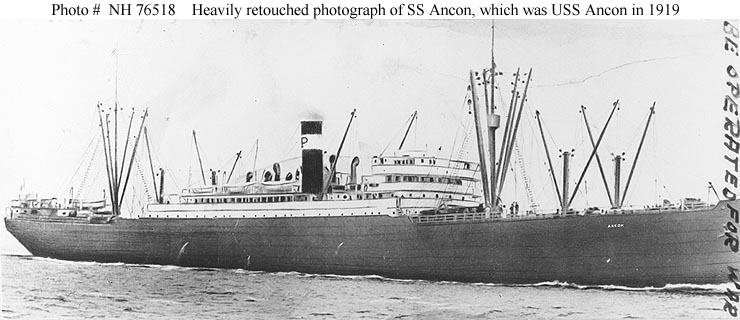
Did you know that before the 1938 Ancon there was an earlier one? Yes there was... it was an American Freighter built in 1902... it too was called the Ancon. This Ancon was the official first transit of the Panama Canal on opening day August 15, 1914
The Ancon, was a 9332 gross ton cargo steamship, that was built in 1902 at Sparrows Point, Maryland. The Navy acquired her from the U.S. Army in mid-November 1918 and converted her to a troop transport for use during the post-World War I redeployment of forces back to the U.S. from Europe. It was then commissioned as USS Ancon. In late March 1919, she made two round-trip voyages between France and the United States. The ship was decommissioned at New York City in July 1919 and returned to the War Department.
Here is a tidbit for all you history buffs;
The ICC bought the SS Shawmut and the SS Tremont from the Boston Steamship Company in 1908 and renamed them the Ancon and Cristobal. These ships operated between New York and Colon until 1939, when they were replaced by the "Panama Liners of 1939", the Ancon, Cristobal, and Panama.

In David MCCullough's classic, "The Path Between the Seas"...The Creation of the Panama Canal 1870 - 1914; the cover shows the steamer Ancon southbound as it clears the cut on August 15, 1914.

The country of Panama is located just 9 degrees above the Equator. It is a lost paradise of enchantment. It is a place dreams and fabulous memories. You can be part of it all...Come to Panama... it is more than a canal.

More about my books ...
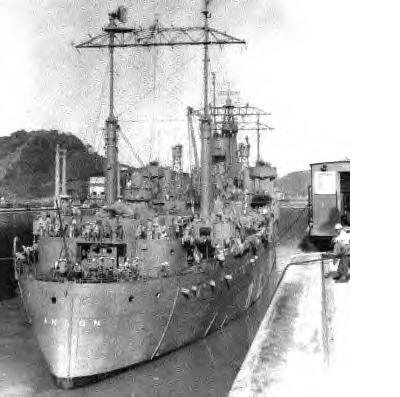
Here is the USS Ancon ACG-4 locking through northbound at Miraflores Locks. The Ancon was a frequent visitor to Panama during the war years.
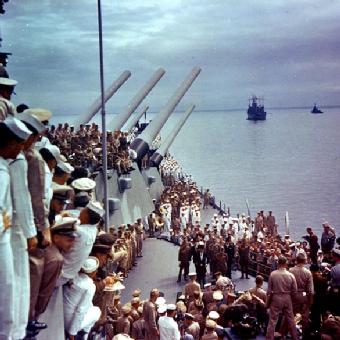
Here you can see the sailors on the USS Missouri BB-63 in Tokyo Bay getting a glimpse of the official surrender of the Imperial Naval Forces of Japan. The USS Ancon ACG-4 was there. She is the center ship a few points off the bow of the Missouri.

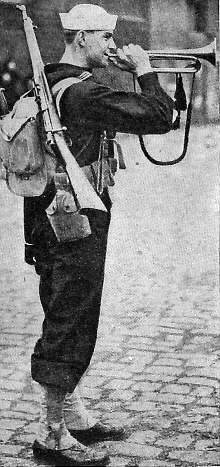
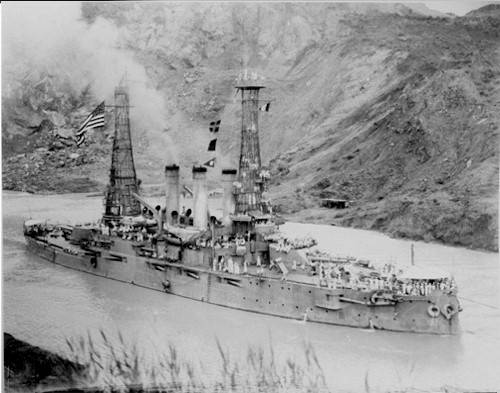
The United States Navy in Panama...
Time is what life is all about…
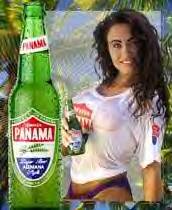



E-MAIL ME!

Picture credits: Author, Bill Fall, David McCullough book's "The Path Between The Seas," US Navy archives, Naval Historical Society and USS Constitution archives.
Mighty A
|

|
|
|


